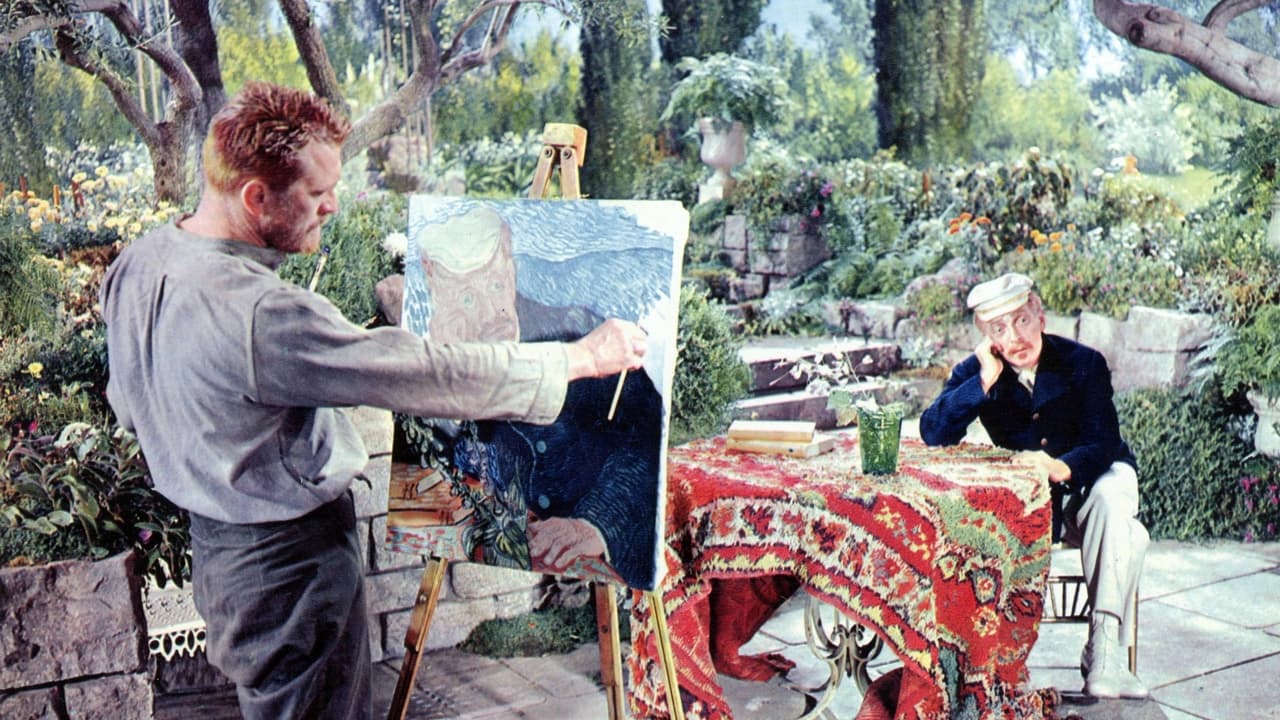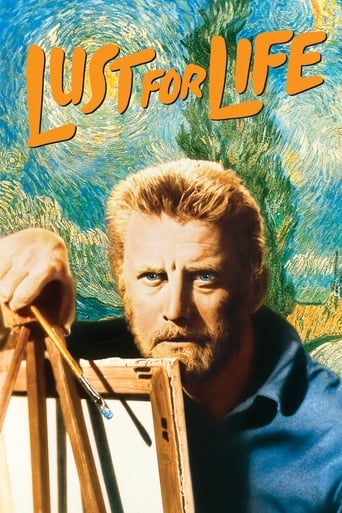

An Exercise In Nonsense
... View MoreA Disappointing Continuation
... View MoreFun premise, good actors, bad writing. This film seemed to have potential at the beginning but it quickly devolves into a trite action film. Ultimately it's very boring.
... View MoreThis is one of the few movies I've ever seen where the whole audience broke into spontaneous, loud applause a third of the way in.
... View MoreCopyright 1956 by Loew's Inc. A Metro-Goldwyn-Mayer picture. New York opening at the Plaza: 17 September 1956. U.S. release: 21 September 1956. U.K. release: 25 August 1957. London opening at the Curzon. Australian release: 7 March 1957. 10,991 feet. 122 minutes.NOTES: Young photographed the European locations, Harlan the Hollywood studio scenes.Academy Award, Anthony Quinn, Best Supporting Actor, defeating Don Murray in "Bus Stop", Anthony Perkins in "Friendly Persuasion", Mickey Rooney in "The Bold and the Brave", Robert Stack in "Written on the Wind". Also nominated for Best Actor, Kirk Douglas, losing to Yul Brynner in "The King and I"; Norman Corwin for Best Adapted Screenplay, losing to "Around the World in 80 Days"; Color Art Direction, losing to "The King and I".Negative cost: around $2.5 million. Initial domestic rentals gross: $1.6 million. Foreign rentals: around $1 million. Initial loss: around $1.2 million.The final film to be photographed in Ansco Color, a process which M- G-M had actively helped to develop.VIEWER'S GUIDE: Not suitable for children, but make them watch it anyway.COMMENT: Based on Irving Stone's superficial and romanticized biographical novel of Vincent Van Gogh, "Lust for Life" was adapted for the screen by (of all people!) radio playwright, Norman Corwin. The result is the one-dimensional characterization and comic caricatures of "The Odyssey of Runyon Jones". A faulty script was then aggravated by handing it over to a sympathetic director — Vincente Minnelli, a specialist in caricature cameos. Minnelli has enjoyed himself hugely; we have his sarcastic observation of the roisterers at the fair, and to cap one of the film's more solemn and dramatic moments, the scatter-brained stupidity of the asylum doctor, hilariously portrayed by Lionel Jeffries.Nonetheless, Kirk Douglas and Anthony Quinn handle the script better than could be expected, and as might be anticipated from the director of "The Bad and the Beautiful", Minnelli's treatment of the scenes of dementia are quite effective. Miklos Rozsa's evocative score is also to be commended, as is Dore Schary's enterprise in allowing the film to be produced at all — one of the reasons why he got the sack.Visually the film contains some attractively composed French and Dutch exterior scenes and the reproduction of the paintings is often above average, although CinemaScope seems an inconvenient shape for the display of such canvasses (Frederick A. Young and Russell Harlan photographed).For his brief role as Paul Gauguin, Anthony Quinn received the lion's share of the critical acclaim, as well as his second Academy Award as Best Supporting Actor. Kirk Douglas, however, won the New York Film Critics Award as Best Actor for his interpretation of Van Gogh.
... View MoreMaybe this 1956 film, made the year I was born, hasn't aged well, but I never quite believed the protagonist here was anyone other than Kirk Douglas of New York City.The biopic tries to convey how lonely, ostracized, and exasperated the artist was, but Douglas's portrayal seemed a little too large for the setting and his exaggerated reactions to things started to grate. Granted, Van Gogh likely was a schizophrenic with some very troublesome behavior but somehow this depiction didn't quite satisfy.The film does a good job of taking us for an art tour through van Gogh's life, as we watch his work develop from the more understated to the exquisitely expressionistic (i.e., Starry Starry Night).This film prompted me to look up the author on Wikipedia. Irving Stone researched the source for this film mostly by reading Van Gogh's letters.Clearly Van Gogh was a tortured person but I wonder if we'd gain a more nuanced idea of him by sticking with the book.
... View MoreLust for Life (1956)A huge, idealized, widescreen, full color homage to the great Dutch artist. Kirk Douglas is really good in a role that is pretty impossible--who knows what Van Gogh was really like? And director Vincente Minnelli makes it beautiful, paces it well, and knows an epic story built around one man when he sees it.But be sure to know this is a sanitized and idealized version of the artist, and his friends. Gauguin isn't chasing 13 year old girls here, and van Gogh's madness is shown as a kind of fervor for truth and goodness. Maybe so. This is easily and fairly compared to the more recent and more gritty "Vincent & Theo" and as much as the newer one is better in its "realism" this version has a kind of drama and Hollywood gloss that's more pleasant than I expected. Minnelli is an amazing director at his best (like "The Bad and the Beautiful") and you can feel a visual, lyrical sense here that counteracts some of the sanitizing of the facts.And some of the truth comes through, as well--Van Gogh's cutting off his ear, his maniacal need to paint, his isolation due to his odd personality. Douglas is terrific overall, even looking a little like the artist. This version includes an important and often neglected part of Van Gogh's life, the years where he tried to be a Christian preacher before turning fully to art. It's a little over simplified, but it's an important part of understanding two things. First, his deep and unexplained need to do good, to work hard, to aim high. Second, the devotion and generosity of his brother (Theo) through it all.And then there are the paintings, which take center stage by the end. Appropriately. It's always a little odd when a movie about an artist ignores his art (as in the strained "Modigliani," for one). Here we get the artist as a man, but also the artist as the artist, which is the reason the film was made in the first place. In the end this is an unexciting but never bad movie. That's condemning with faint praise, I know, but you can predict whether you'd like a more conventional film like this one or one that pushes a little more realistically and frankly awkwardly into the man's world in "Vincent & Theo." Watch them both!
... View MoreBiopics are tricky things to get right. That is one of the reasons why so many classic Hollywood versions of true stories are so liberal with the facts – storifying history in order to bring out the spirit or the legend of the subject. There have also been more recent productions which, in their devotion to historical accuracy, suck all the life out of the picture. It is a rare thing indeed then to find a biopic that sticks to the truth but also really brings us a vivid character in an engaging story.Lust for Life begins with Vincent's journey in mid-flow, with a brief episode in which he worked as a preacher in a dirty mining town. It is as if we are observing the man from a distance, and indeed director Vincente Minnelli actually keeps his camera well back from the subject for the first fifteen minutes or so. Van Gogh's talent for painting is not referenced verbally, but sketches gradually begin to appear in the background. It's a very tentative introduction to the man, but it gives us his character and background through example rather than direct statement, and rather than highlighting his turning to art shows it as an almost incidental extension of his way of life. Screenwriter Norman Corwin (who normally worked in radio) draws from Vincent's letters to his brother Theo for a gentle and unobtrusive narrative, and the production makes extensive use of actual locations and colour prints of van Gogh's paintings, all the better for his work to speak for itself.Director Vincente Minnelli was himself a painter, albeit one of a rather different style to van Gogh, but his painterly instinct for space and colour helps very much in creating the harmonious look of Lust of Life. He was one of the few directors from this early stage of widescreen who knew what to do with the Cinemascope aspect ratio. His technique is to soften the width by composing in depth. Take set-ups like Mauve's studio or the little flat Vincent shares with Christine, in which the furniture and canvasses create many layers in depth, giving real definition to the space and making the wide shape of the screen seem more natural. Often the screen seems loosely divided into two parts, with foreground business on one side and a distant vanishing point on the other, and Minnelli uses this to create smaller frames for different actors on the screen or to highlight one person or another. This in turn minimises the need for cuts to opposing angles or close-ups, which tend to look awkward in Cinemascope.In the lead role, Kirk Douglas not only bears a passable resemblance to van Gogh, he really immerses himself in the character to the extent that you forget the familiarity of the actor and see only the painter. Vincent may be the archetypal tortured artist but Douglas resists the temptation to become wild or hysterical, more often showing emotional turmoil in tense body language and silent screams. In lighter moments he displays a kind of boyish enthusiasm which really helps to make a likable character out of van Gogh. In contrast Anthony Quinn's supporting role as Paul Gauguin is exaggerated and theatrical where Douglas is subtle and realistic, but it highlights the difference between the two men and helps to make Quinn's short but crucial part in the story lively and memorable.Above I feel what really makes Lust for Life work is that it understands it subject matter. There is a clear respect for van Gogh's work from writer, director and star, and an intention to allow the audience to share in this appreciation. The effort that has gone into comparing real scenes to finished paintings, and the dialogue that touches upon art theory show how his approach to painting dovetails into his highly emotional and philanthropic character. It is this that lends a sense of meaning and poignancy to the depiction of his tragic life.
... View More